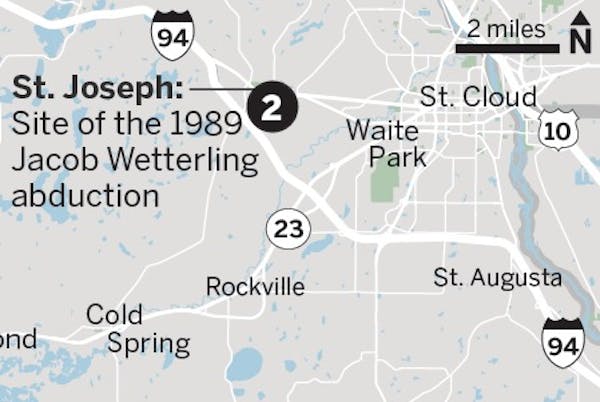ST. CLOUD – Investigative mistakes and misplaced effort in the days, weeks and months following the 1989 abduction of Jacob Wetterling prevented authorities from making Danny James Heinrich the prime suspect in a case that haunted Minnesotans for nearly 30 years.
Based on what investigators learned about Heinrich soon after Wetterling's disappearance — such as tire tracks, a shoe print and a tip that clearly linked the former Paynesville loner to the case — Heinrich should have been the primary suspect within 48 hours of the kidnapping, Stearns County Sheriff Don Gudmundson said Thursday.
For inexplicable reasons, he said, a task force assembled to find Wetterling and the masked man who abducted him wasted more time chasing far-flung leads and conferring with psychics than tracking compelling evidence close to home.
"It went off the rails," Gudmundson said of the investigation in the weeks following the 11-year-old's kidnapping at gunpoint in St. Joseph, Minn., in October 1989. "It went off the rails very quickly."
It would take 27 years for investigators to circle back to Heinrich and find a way to compel him to admit to killing Jacob and then lead them to the boy's remains in a pasture in Paynesville.
Gudmundson, who was not involved in the original investigation and became Stearns County sheriff in May 2017, held a news conference at the Stearns County Law Enforcement Center on Thursday detailing his analysis of the investigation before releasing thousands of pages of case documents. His presentation, expected to highlight exhaustive work by dozens of investigators over nearly three decades, instead was a pointed criticism of investigative "tunnel vision."
The Wetterling file, he said, reveals myriad missed opportunities to catch Jacob's killer in the months after the boy was snatched on a remote dirt road while returning home from a convenience store with his brother, Trevor, and best friend, Aaron Larson. The law enforcement failures stretched back years — even before Wetterling was abducted — with some eight victims in the area having been attacked in a similar manner by a stocky, raspy-voiced man.
"There were around 20 things" that pointed to Heinrich that investigators should have pieced together, the sheriff said when questioned by reporters after his 135-page slide presentation. He said he was at a loss to explain why those clues were missed or dismissed.
Gudmundson faulted a lack of cooperation among local, state and federal agencies but seemed at times to place most of the blame for the investigative blunders on the FBI. When pressed on the point, he said, "All of us failed."
In particular, a shoe print and tire tracks at the scene tied to Heinrich were clear indicators that Heinrich should have been the lead suspect early on.
Gudmundson said the odds were "not just slim, but minuscule" that those prints and tracks belonged to someone other than Heinrich, the only person investigators identified as having Sears Superguard steel radial tires matching tracks found at the scene.
The documents released Thursday became public after a yearlong legal dispute with the Wetterling family, which had sought to keep some private. The federal government clawed back some of the file — more than 12,000 pages that originated with its investigators, Gudmundson said. They are now available only through a federal Freedom of Information Act request.
Absent the FBI documents, Gudmundson said the public should not expect to have a "good or complete [understanding] about some of the events in the Wetterling case." If FBI officials want to challenge his assessment, he said, they should "release their files."
On Thursday, in a statement by the FBI's Minneapolis office, officials said a state court ordered that the federal records in the case be returned to the FBI. It said that requests to view those files "are currently pending."
Immediately after Gudmundson stepped away from the lectern in front of a room crowded with journalists and law enforcement, former FBI agent Al Garber, who supervised the original investigation, challenged the sheriff's account.
"He has his beliefs, he has his understanding and he was going to make it fit the facts in this case," Garber said. "I was there. I saw it every day."
After about a minute, Gudmundson directed Garber to "take it outside." He did, with cameras and reporters trailing him to the sidewalk under gray sky and drizzle.
Missed opportunities
Gudmundson's narrative began with details of assaults that happened months before Wetterling disappeared, including the abduction and sexual assault of a boy in Cold Spring that bore chilling similarities to Jacob's case.
In January 1989, Jared Scheierl of Cold Spring was kidnapped and sexually assaulted in a vehicle that he later said closely matched the interior of Heinrich's car.
Despite that evidence, a law enforcement task force waited a month after Wetterling's abduction before raising a possible connection to the January attack in which Heinrich was a suspect, Gudmundson said.
"The first mention of the Cold Spring abduction and assault is on November 30th," the sheriff said. "Essentially, the [Wetterling] task force has been spinning its wheels" for more than a month after Jacob was kidnapped.
Eight other assaults or sexual assaults in Paynesville were reported over more than two years before the Wetterling abduction. Those assaults were perpetrated by a heavyset man who wore face-paint or a mask, spoke in a deep, raspy voice and threatened victims with a gun.
Instead of zeroing in on Heinrich, Gudmundson said, the task force focused on a suspect identified as Duane Hart, a convicted Paynesville sex offender and onetime friend of Heinrich's brother. The focus on Hart came despite other reasons to suspect Heinrich, including his failing a polygraph test given by the FBI, the sheriff said.
On Jan. 8, 1990, the Paynesville police chief said Heinrich should be considered a suspect.
Gudmundson also noted that an artist's sketch of the suspect at that time bore a "strong resemblance" to Heinrich.
Later, in an interview with investigators, Heinrich was "deceptive" about the Wetterling kidnapping.
During a search of Heinrich's property, police found a locked trunk with photos of children, including one of a boy exiting a shower with a towel around his neck. Heinrich objected to the confiscation of the photos, saying they "just didn't look right."
"Inexplicably, they were not confiscated," Gudmundson said, and Heinrich later burned the photos.
On Feb. 7, 1990, Heinrich appeared at the Sheriff's Office angry that rumors were circulating that he was homosexual. Two days later, Gudmundson said the "most fatal flaw" in the investigation occurred, when Heinrich was arrested late at night at a bar in Roscoe, Minn., and interrogated by FBI agents.
Heinrich, who Gudmundson said was intoxicated, demanded to know whether he was under arrest. Gudmundson called the FBI's decision to interview him at that time "a serious mistake," adding that "we regard the interrogation as perhaps the most fatal flaw in the Wetterling investigation."
He said arrests in cases like that are generally meticulously planned. "One would never willingly arrest someone drunk late at night," the sheriff said, adding that the two FBI agents who interviewed Heinrich were inexperienced.
Meanwhile, the sheriff said, state Bureau of Criminal Apprehension agents on the case, whom he called out by name, were seasoned investigators but "kept at arm's length through the course of this investigation, running meaningless leads."
After that interrogation of Heinrich, the Stearns County attorney directed authorities to release him, citing a lack of evidence, Gudmundson said. He said investigators didn't take a hard look at Heinrich again for 20 years.
Jim Kostreba, who was the Stearns County chief deputy sheriff when Jacob was abducted, said it was a trying time for investigators.
"Were there missteps? It's hard to say," he said. "You always have to consider the fact that when an investigation goes on for as long as that, there are so many different people involved and so many different agencies. It's easy to go back and say there were missteps and that we should have done things differently."
A continuing mystery
In the nearly three decades since Jacob disappeared, his name never faded from the public consciousness. His abduction remained one of the great unsolved mysteries for generations of Minnesotans and put a face to every parent's worst nightmare. It also has led to much criticism of the investigation.
At one point, in 2010, investigators took excavators to the farm of Dan Rassier, who lived near the Wetterlings and whose driveway was near the spot where Jacob was abducted. The scrutiny of Rassier was intense — the Stearns County sheriff at the time, John Sanner, identified him as a "person of interest" in the case.
Rassier has since sued Sanner, Stearns County and the BCA in federal court, claiming they defamed him and caused him emotional distress.
It wasn't until 2016 when Heinrich, under pressure from federal investigators who had found child pornography on his home computer, confessed and led law enforcement to Jacob's body. Heinrich had buried the boy's remains in a pasture outside Paynesville, where Heinrich lived at the time of Jacob's disappearance.
Jerry Wetterling, Jacob's father, didn't comment on Gudmundson's assertions, saying he simply attended the news conference to watch and listen. Patty Wetterling, Jacob's mother, was on her way to Washington, D.C., Thursday morning and could not be reached for comment.
However, on the eve of the release of the case documents, the couple issued a written statement expressing concern over the file's contents and the potential for finger-pointing or accusations made by tipsters over the years against neighbors, friends or relatives.
"Our hearts hurt for anyone pained or hurt from the release of this file," the statement said.
The documents had been tightly held by law enforcement for nearly three decades. With the closing of the case, the file became public under Minnesota law. As victims, the Wetterlings were allowed to review the documents before the release.
Days before the file was to be made public in June 2017, the family sued, seeking to withhold nearly 200 documents of an estimated 56,000 pages. Media and open government organizations opposed that effort. The Stearns County prosecutor had determined that state law required the release of the full file. A judge ultimately ruled in favor of the release, and the Wetterlings ended the fight rather than appeal.
Staff writers Pam Louwagie, Paul Walsh, Dan Browning and Mary Lynn Smith contributed to this report.

Want to share info with the Star Tribune? How to do it securely

'Safe recovery sites' would offer syringes, naloxone and more to people using drugs. The plan could be in peril.
New Minnesota GOP leaders seek peace with party's anti-establishment wing

Who is Republican Lisa Demuth, Minnesota's first House speaker of color?



